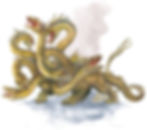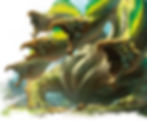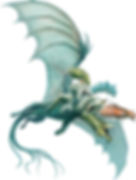Monster Monday #5: Hydra
- Katrina Waldman
- Nov 1, 2021
- 7 min read
Updated: Mar 4, 2023

The Hydra, or more specifically the Lernaean Hydra, is a beast famed for its appearance in Greek Mythology as the second of the Twelve Labours of Heracles/Hercules. When people think of this creature they most likely first think of its many heads - the legends differ on how many exactly though many settle on nine and they mostly agree that the heads grow back and even double in number each time one is cut off. The Hydra is also known for it's poisonous breath and blood, so strong that just being near it and breathing it's scent is toxic.
The Hydra Of Lerna is so named because of its lair, the lake of Lerna in the Argolid, which was rumoured to be an entrance to the Underworld. As a serpentine water monster, it is also a form of mythical Sea Serpent, and in some depictions is seen to slither around like a snake while in others it has four legs and wades through the waters. In the original myth, Heracles/Hercules is said to have killed it with the help of his nephew, Iolaus, by cutting off all of the monster's heads and cauterising the neck before they could re-grow with a sword and fire. The Hydra is not the only many-headed snake-like creature that he fought though - the Ladon was said to have one hundred heads.
While the Hydra itself is a unique monster, there are actually many similar legends in folklore and mythology world-wide that depict an epic battle between a heroic figure and a serpentine or draconic creature. Still within Greek mythology, Zeus fought Typhon, the monster that supposedly fathered the Hydra. The eight-headed and eight-tailed Japanese dragon/serpent named Yamata no Orochi is said to have fought with Susanoo. Babylonian mythology depicts the great battle between Marduk and Tiamat, both deities. Even Thor's mighty battle with Jörmungandr in Norse mythology is an example of this. This phenomena is called Chaoskampf and seems to represent the ideals of a battle between culture and civilisation (the hero, or figure that epitomises that culture's ideals) and chaos (the chaotic monster). It's polycephalic nature is just to highlight the chaotic, unnatural existence of the creature itself.
There are many examples of this creature found within pop culture too. It of course makes an appearance within Disney's classic film Hercules as a creature that the titular character faces early in his career as a hero. King Ghidora is found in the film Godzilla, clearly drawing inspiration from the Chaoskampf creatures of legend. In the Marvel Universe (both in the comics and movies), HYDRA refers to the villainous organisation that infiltrate heroic organisations such as SHIELD and they even refer to the fact that every time they are defeated, they reform (just like the Hydra's head). Video games inspired by mythology, such as God Of War, Hades, and Titan Quest obviously feature this fantastical monster, and other big franchises such as Final Fantasy feature them as a recurring enemy.
So now comes everyone's favourite part - getting the Hydra into your game! It will probably come as no surprise to anyone that this is actually very easy to do. Wizards Of The Coast have already provided some fantastic stat blocks in various book releases so I'll start with those!

The basics first - Hydra (Basic Rules, page 41).
So this was THE Hydra stat block for the longest time and at a CR 8 in the size category Huge, it does a good job of recognising that this creature would be a tough encounter, though higher tier play would probably have to see your party go up against multiple Hydras to really give them a challenge. But it gives the Hydra it's foundational powers - the obvious Multiattack, the benefits of having Multiple Heads and the regenerational power that comes alongside that, and the ability to have as many Reactions (AKA Opportunity Attacks) as they have heads. Known for living in swamps, they've given this stat block a Swim speed too which tracks with the real-world lore. This is a solid choice for an encounter with this legendary creature.

Next, let's move onto a stronger version of the beast from a book that we probably all saw coming. The Ironscale Hydra (Mythic Odysseys Of Theros, page 231).
If you thought the last stat block looked intimidating, then this one is even scarier. Considering the legendary status of the real-world Hydra, this feels more along those lines - CR 12 and Gargantuan size category. Generally it shares most of its abilities with the above stat block, but with the added Acidic Blood feature which matches a lot of the real-world lore on the Hydra's blood. With a natural AC 17, it's clear to see where the name came from and it makes hitting this creature much harder. I'm a big fan of this stat block - it FEELS like a Chaoskampf style level of power, especially when matched up with the power of the Typhon stat block (Mythic Odysseys Of Theros, page 246), which is supposed to be a more powerful, multi-headed being fought and defeated by a God instead of a Demi-God and is CR 15.

However - perhaps you want your Hydra to be a God too? In which case, consider Polukranos (Mythic Odysseys Of Theros, page 231).
This is pretty much the ULTIMATE Hydra and is really only an encounter for high tier play at a CR 19. Not only does it take and increase the power of the best elements of the Ironscale Hydra, it also gets some Legendary Actions on top of that just to really keep things interesting. I wish they had given this stat block some of the book's famous Mythic Traits, as this is DEFINITELY a Mythic beast? But it has everything you need for a cool, memorable encounter and it's one that will definitely keep a party on it's toes.

Alright, so let's dial it back a bit and maybe have some fun...what if your Hydra could fly? Meet the Dracohydra (Fizban's Treasury Of Dragons, page 176).
Clearly the result of some very twisted arcane experiments, here you have the ultimate Chaoskampf monster. Is it a sea serpent or dragon? Why not a bit of both, as it can swim, walk AND fly? And what is more terrifying than a Dragon's Breath Weapon COMBINED with the Hydra's multiple head abilities? It's a CR 11, and no longer Gargantuan (though still Huge) but certainly a difficult encounter. Of course, if you want the ULTIMATE multi-headed Dragon encounter you could always pit your party against Tiamat (Rise Of Tiamat, page 92) herself? Though at a CR 30 that is NOT an encounter for the faint-hearted...
I think that Wizards Of The Coast have pretty much hit the nail on the head with Hydra stat blocks, but I did have a browse around on DM's Guild to see if there were any fun takes worth mentioning and I stumbled upon a variety in Dragonix's expanded Monster Manuals. In Monster Manual Expanded there are a number of stat blocks that create some interesting Hydras - try the Cryohydra (page 160) for an icy variant, the Gulguthydra (page 162) if you like your Hydras mixed with Otyughs, or the Pyrohydra (page 163) if you want to switch up the Hydra's natural aversion to Fire damage with Cold damage instead. In Monster Manual Expanded II, the Hydra Zombie (page 261) is a fun Undead variant on the classic monster. And the Monster Manual Expanded III has a couple of interesting options - the Nagahydra (page 189), a monstrous hybrid of the human/serpent Naga and the Hydra; and the Thessalhydra (page 237) which really twists up the legendary monster and gives a toothy neck maw and scorpion's tail. This second stat block is probably my favourite as at a CR 12 it takes the stat block from the Wizards Of The Coast collaboration with Stranger Things (Hunt For The Thessalhydra, page 46) and makes it TERRIFYING.
Looking to the internet, I also found some interesting, fun adaptations. Dev The DM has come up with a plant variant - the Hydra Vine. I particularly enjoy the potential for this creature to pop up anywhere heavily overgrown with flora, and the artwork is really cool! I was also a fan of DMDave's Abyssal Hydra, as it makes a lot of sense that there could be a demonic version of this monstrous creature. While I'm here I can't forget to talk about the absolute stuff of nightmares - the False Hydra. While this may not be a Hydra in the conventional sense, it has some really interesting lore around the idea of your players forgetting that they have seen it once they have encountered it (a little bit like The Silence in Doctor Who if you are a fan of that show). Goblin Punch have a TERRIFYING article on them and there are many stat blocks available on the internet if you look them up! A great villain for a spooky one-shot that will mess with the minds of your players as they have a real Creepypasta vibe to them AND human faces!
Okay so, back to the mythical monster of old. How do we get them in your game? Here are a few plot hooks to help!
Your players enter a gladiatorial style/arena based competition to fight monsters and win gold or riches. As the huge doors open, low hisses and growls can be heard from the other side and the creature slithers out.
A town are terrified to venture through the swamps nearby as there is a horrifying, many-headed beast living within the waters, snatching those that venture too close to its lair. Your players are hired to defeat it.
An egg has been found either by an NPC or your players. Once it hatches, it is found to be a baby Hydra. What will they do with it?
The God that one of your players worships visits the player in a dream. They need something that is being guarded by this beast in a lake not too far from here. The God gives them a little information on what to expect, but in a cryptic manner.
A mage has been performing horrifying experiments on some already monstrous creatures - your party has been informed and venture out to stop this twisted sorcerer, but find they are being guarded by their own creations.
I hope you enjoyed this deep-dive into some of the lore surrounding the Lernaean Hydra! Was this information useful? Have your party ever fought a Hydra before? Let me know if you've come across any fun, multi-headed creatures in your DnD games!
